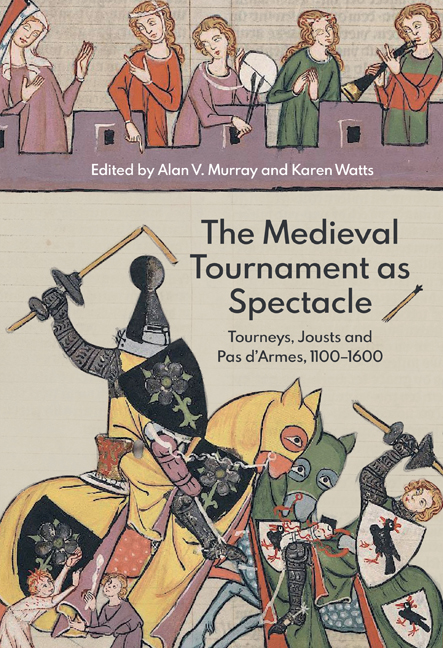Book contents
- Frontmatter
- Contents
- List of Illustrations
- List of Contributors
- Preface and Acknowledgements
- Introduction: From Mass Combat to Field of Cloth of Gold
- Research on the Medieval Tournament (1100–1600): A Select Bibliography
- 1 Now Form Up Close Together! Tactics and Ethos of the Tourney in Early German Sources (Twelfth to Thirteenth Centuries)
- 2 Por pris et por enor: Ideas of Honour as Reflected in the Medieval Tournament
- 3 Richard II of England and the Smithfield Tournament of October 1390: An Instrument to Establish Royal Authority
- 4 Alle myn harneys for the justes: Documents as a Source for Medieval Jousting Armour
- 5 The Tournament Saddle
- 6 Between Sport and Theatre: How Spectacular was the Pas d’armes?
- 7 Art Imitating Life Imitating Art? Representations of the Pas d’armes in Burgundian Prose Romance: The Case of Jehan d’Avennes
- 8 The Foot Combat as Tournament Event: Equipment, Space and Forms
- 9 Power and Pageantry: The Tournament at the Court of Maximilian I
- 10 The Field of Cloth of Gold: Arms, Armour and the Sporting Prowess of King Henry VIII and King Francis I
- Appendix 1 Calendar of the Royal Combats at the Field of Cloth of Gold, June 1520
- Appendix 2 Articles for the Challenge: The Emprise
- Index of Objects
- Index of Manuscripts
- General Index
5 - The Tournament Saddle
Published online by Cambridge University Press: 11 September 2020
- Frontmatter
- Contents
- List of Illustrations
- List of Contributors
- Preface and Acknowledgements
- Introduction: From Mass Combat to Field of Cloth of Gold
- Research on the Medieval Tournament (1100–1600): A Select Bibliography
- 1 Now Form Up Close Together! Tactics and Ethos of the Tourney in Early German Sources (Twelfth to Thirteenth Centuries)
- 2 Por pris et por enor: Ideas of Honour as Reflected in the Medieval Tournament
- 3 Richard II of England and the Smithfield Tournament of October 1390: An Instrument to Establish Royal Authority
- 4 Alle myn harneys for the justes: Documents as a Source for Medieval Jousting Armour
- 5 The Tournament Saddle
- 6 Between Sport and Theatre: How Spectacular was the Pas d’armes?
- 7 Art Imitating Life Imitating Art? Representations of the Pas d’armes in Burgundian Prose Romance: The Case of Jehan d’Avennes
- 8 The Foot Combat as Tournament Event: Equipment, Space and Forms
- 9 Power and Pageantry: The Tournament at the Court of Maximilian I
- 10 The Field of Cloth of Gold: Arms, Armour and the Sporting Prowess of King Henry VIII and King Francis I
- Appendix 1 Calendar of the Royal Combats at the Field of Cloth of Gold, June 1520
- Appendix 2 Articles for the Challenge: The Emprise
- Index of Objects
- Index of Manuscripts
- General Index
Summary
The saddle was an essential part of the knight's equipment, as its role was fundamental for the efficiency of the fighting horseman. It was the direct link between horse and man. The latter needed it to be able to make the most of the advantages and qualities of his mount: strength, speed and mobility, without reducing in any way his fighting skills. During the eleventh century in Western Europe, knights developed a specific fighting technique – the charge with the couched lance. This led to the development of a new war saddle by the end of the twelfth century. Far from being a mere change of fashion, this new saddle was the ultimate improvement of a dominant war technique that lasted for more than five centuries. This saddle differed from travelling or hunting saddles, which were designed for other purposes. As the first tournaments in the twelfth century used regular war equipment, their participants also used regular war saddles, which continued in use until the end of the age of the tournaments in the seventeenth century. Nevertheless, from the fourteenth century onwards, some saddles were designed exclusively for the tournament, with features that would make them totally inappropriate in other contexts.
In the Middle Ages a saddle comprised a wooden saddle-tree, composed of four elements: two saddle bows (the pommel at the front, the cantle at the back) and two sidebars, the only elements of the tree in direct contact with the horse's back on either side of its spine. To these sidebars were usually attached the stirrups and leather straps to which the belly girth was buckled. Over this rigid structure there were soft elements, mainly made of leather: the seat (usually stuffed with hay or animal hair) and the saddle flaps. At the back and the front, buckles could be found for the fixation of crupper straps and breast straps, securing the saddle to the horse.
Evolution of the War Saddle
The saddle used by knights up to the first half of the twelfth century was not very different from that represented in the famous Bayeux Tapestry, dated to around 1080 (Figure 1a). Its general shape consisted of a basic seat between two low saddle-bows. Both pommel and cantle were flat and relatively narrow and while they helped the rider to maintain himself on the horse, they could not prevent him from falling on either side.
- Type
- Chapter
- Information
- The Medieval Tournament as SpectacleTourneys, Jousts and Pas d'Armes, 1100-1600, pp. 99 - 119Publisher: Boydell & BrewerPrint publication year: 2020

